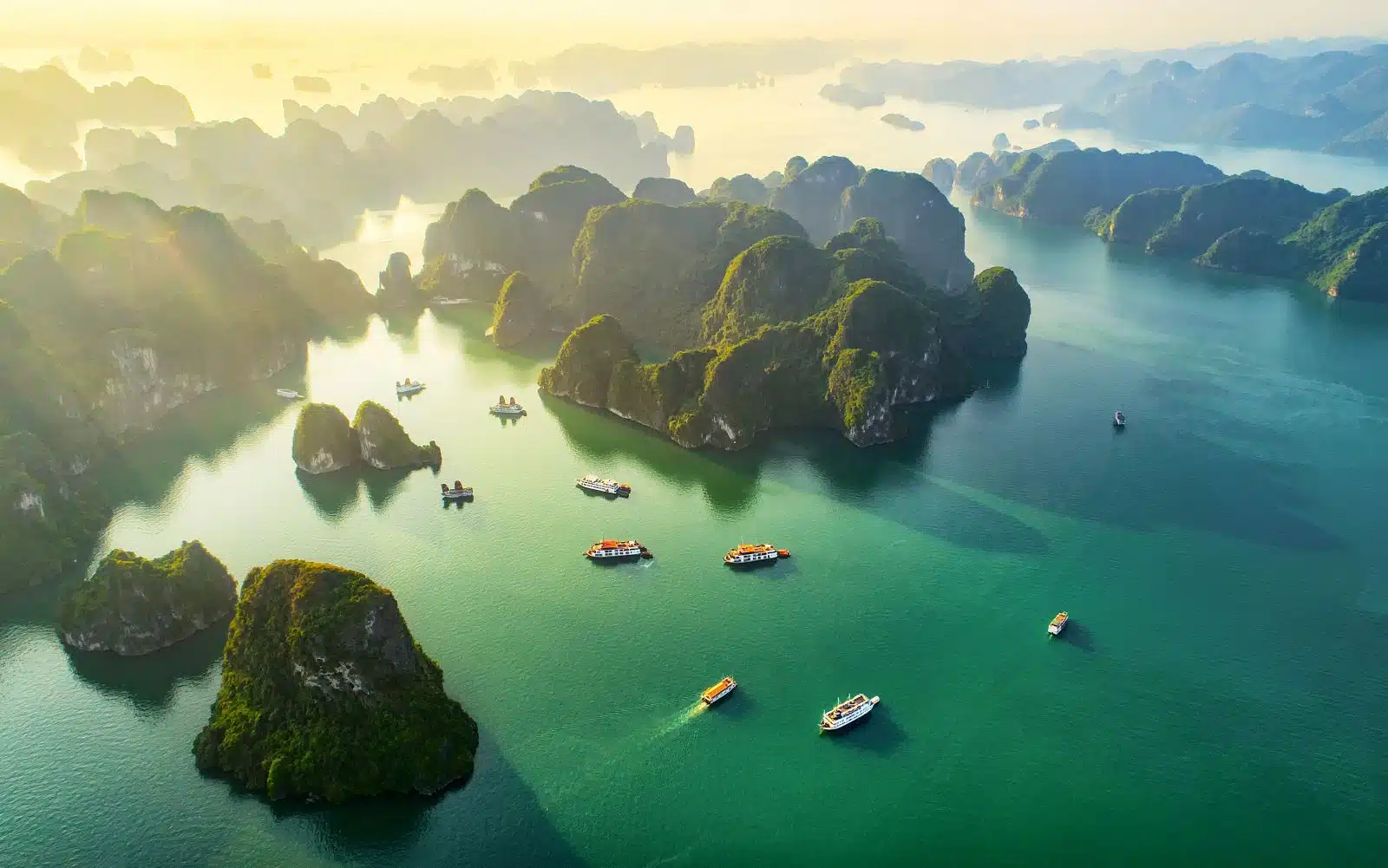Vietnam, a country with a rich history, vibrant culture, and stunning landscapes, offers an array of experiences that cater to every type of traveler. From the bustling streets of Hanoi and the ancient charm of Hoi An to the serene beauty of Halong Bay and the dynamic energy of Ho Chi Minh City, Vietnam is a blend of traditional and modern influences. The country’s diverse landscapes range from lush rice terraces and forested mountains in the north to fertile deltas and white sandy beaches in the south. Vietnam’s culinary scene is just as varied, offering spicy, savory, and sweet flavors that are as complex as its history. This guide will take you through the heart of Vietnam, highlighting must-visit destinations and providing insider tips to ensure a rich and immersive travel experience.
A Brief History
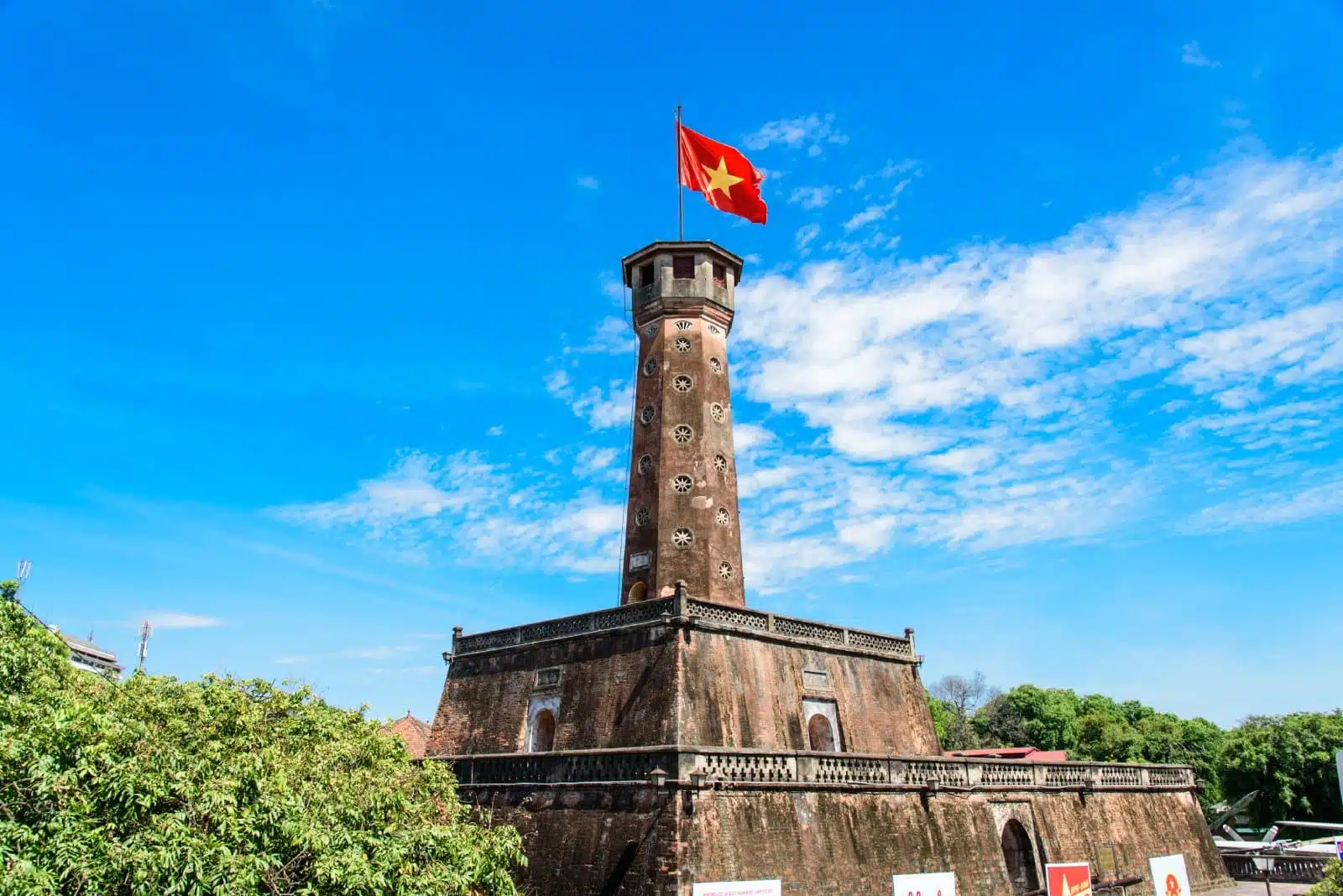
Image Credit: Shutterstock / Trong Nguyen
The history of Vietnam is complex, with foreign invasions and a fierce spirit of independence that has shaped the country for millennia. Stretching back over 4,000 years, Vietnam’s history highlights the resilience of its people and the richness of its culture.
Archaeological evidence suggests that what is now Vietnam has been inhabited since the Paleolithic age. The first known societies, such as the Phung Nguyen culture, began cultivating rice and establishing permanent settlements in the Red River Delta around 2000 BCE. These early agricultural communities laid the groundwork for the development of complex societies.
By the first millennium BCE, the region was home to the Bronze Age Dong Son culture, known for its advanced metallurgy and iconic bronze drums. The Hung Kings established the first historically recorded state in Vietnam, Van Lang (later known as Au Lac), in the 7th century BCE. During this period, the Vietnamese people began to form their identity, which was distinct from that of neighboring civilizations.
In 111 BCE, the Han Dynasty of China conquered Au Lac, beginning a millennium of Chinese rule that influenced Vietnamese culture, language, and governance. Despite this, resistance to Chinese rule was a constant theme, exemplified by the Trung Sisters’ rebellion in 40 CE and the Ngo Quyen’s victory at the Battle of Bach Dang River in 938 CE, which regained Vietnamese independence.
Following independence from China, Vietnam saw the rise and fall of several dynasties, including the Ly, Tran, and Le dynasties, which expanded the country’s territory and developed its feudal system. The Nguyen Dynasty, established in 1802, was the last ruling family of Vietnam, overseeing a period of relative stability and isolation from the Western world until the mid-19th century.
The mid-19th century marked the beginning of French colonial rule in Vietnam, part of the larger French Indochina. This period was characterized by economic exploitation, cultural suppression, and significant infrastructure development at the cost of Vietnamese autonomy and well-being. Resistance to French rule culminated in the Indochina Wars, including the significant battle of Dien Bien Phu in 1954, which ended French colonialism in Vietnam.
The Geneva Accords of 1954 temporarily divided Vietnam into North and South, leading to the Vietnam War (1955-1975), a conflict that would further devastate the country and its population. The war ended with the fall of Saigon in 1975, leading to the reunification of Vietnam under the Communist government of the North.
Since reunification, Vietnam has undergone significant reforms, transitioning from a centrally planned economy to a socialist-oriented market economy. These changes have spurred rapid economic growth, reduced poverty, and increased Vietnam’s integration into the global economy. Despite challenges, including governance, human rights, and environmental sustainability issues, Vietnam today is a dynamic and rapidly developing country with a young population and a vibrant culture.
Vietnam’s history, marked by periods of foreign domination, fierce resistance, and profound resilience, has forged a nation with a strong sense of identity and independence. Its rich cultural heritage and historical legacy continue influencing all aspects of Vietnamese society.
1. Hanoi
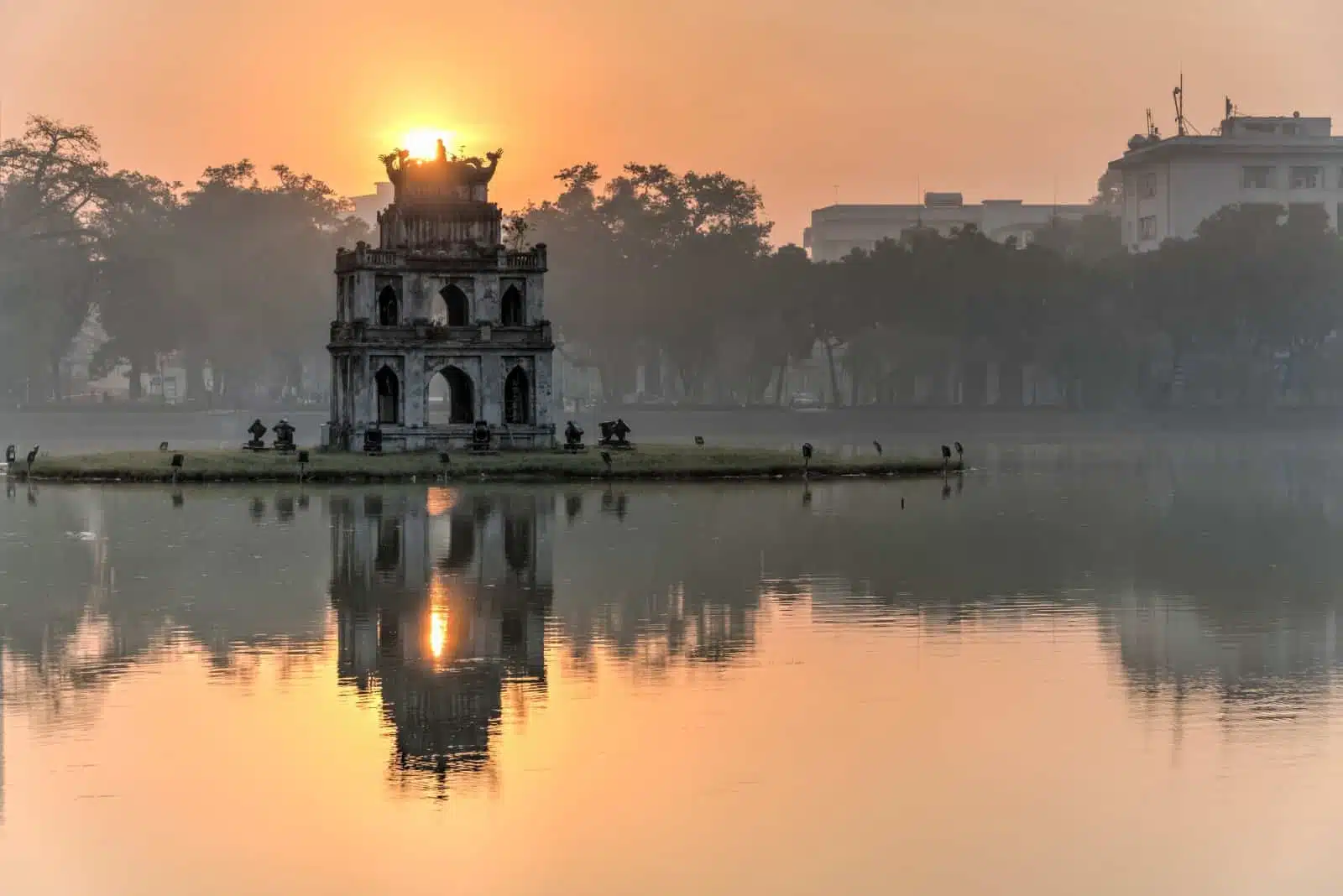
Image Credit: Shutterstock / Trong Nguyen
Hanoi, the capital city of Vietnam, is a fascinating blend of East and West, combining traditional Sino-Vietnamese motifs with French colonial influences. The city’s heart is the chaotic, vibrant Old Quarter, where the narrow streets buzz with life, offering everything from exquisite local cuisine to handicrafts. Notable attractions include the serene Hoan Kiem Lake, the historic Ho Chi Minh Mausoleum, and the Dong Xuan Market. Hanoi is also a city of the arts, with numerous galleries, theaters, and museums, such as the Vietnam Fine Arts Museum and the Hanoi Opera House.
Insider’s Tip: For an authentic Hanoi experience, wake up early to watch or join in the Tai Chi sessions around Hoan Kiem Lake. It’s a serene way to start your day before the city wakes up.
When to Travel: The best times to visit Hanoi are during the spring (March and April) and autumn (October and November) months when the weather is pleasant with milder temperatures.
How to Get There: Hanoi is served by the Noi Bai International Airport, located about 45 minutes from the city center. Direct flights are available from major cities worldwide.
2. Halong Bay
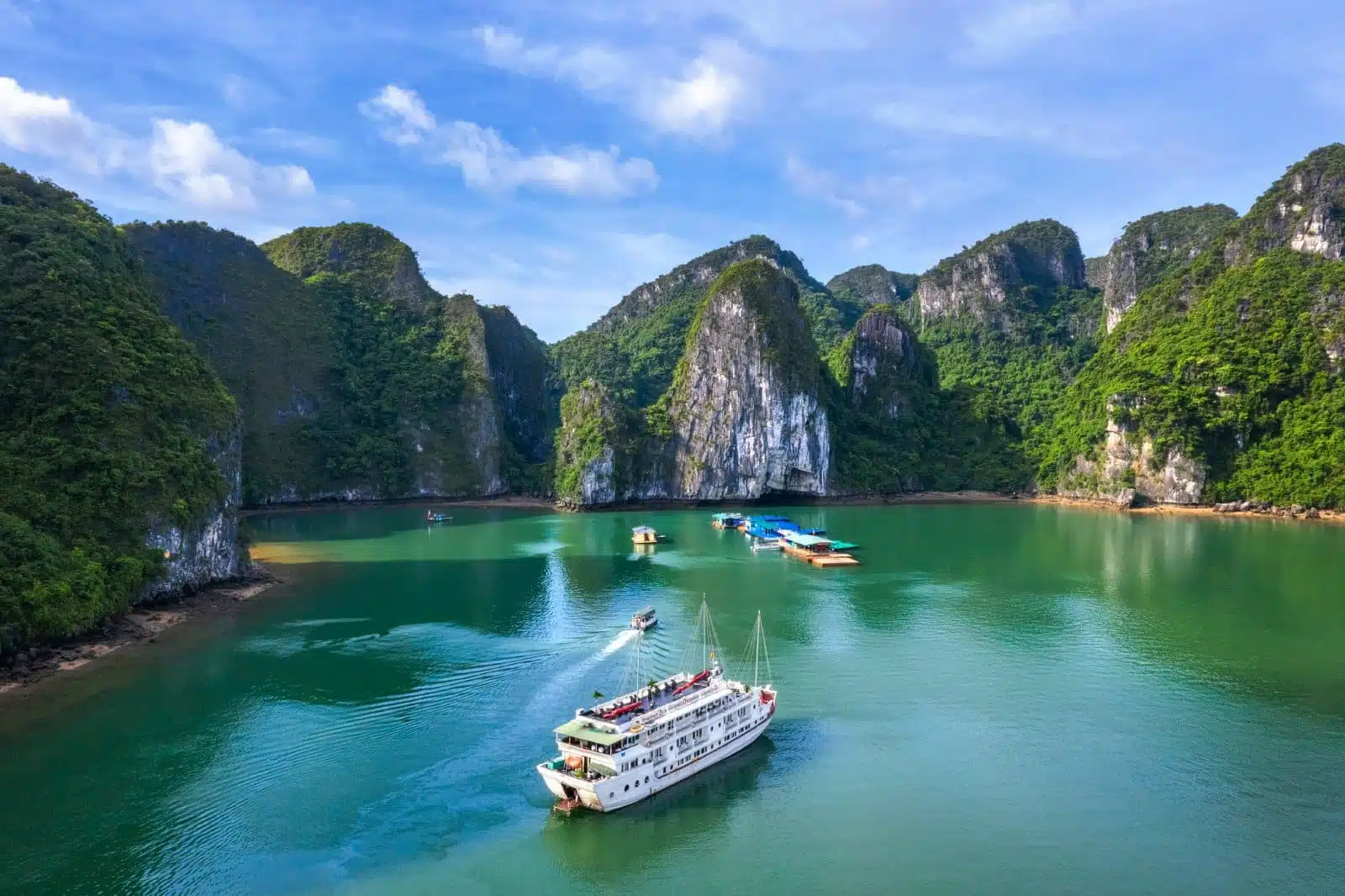
Image Credit: Shutterstock / Hien Phung Thu
Halong Bay, a UNESCO World Heritage site, is renowned for its emerald waters and thousands of towering limestone islands topped with rainforests. A cruise through the bay offers breathtaking views and the chance to explore secluded beaches, caves, and floating villages. Activities include kayaking, swimming, and spelunking in caves like Sung Sot or Thien Cung. Halong Bay is a place of natural beauty and features Vietnam’s geological and cultural richness.
Insider’s Tip: Opt for an overnight cruise to experience Halong Bay’s stunning sunrise and sunset. Lesser-known cruise routes offer a more secluded and unique experience away from the crowds.
When to Travel: March to May and September to November are ideal, offering pleasant weather and clearer skies for exploring the bay.
How to Get There: The most common way to reach Halong Bay is by road from Hanoi, which takes about 2-4 hours. Several tour companies offer shuttle services or private transfers.
3. Hoi An
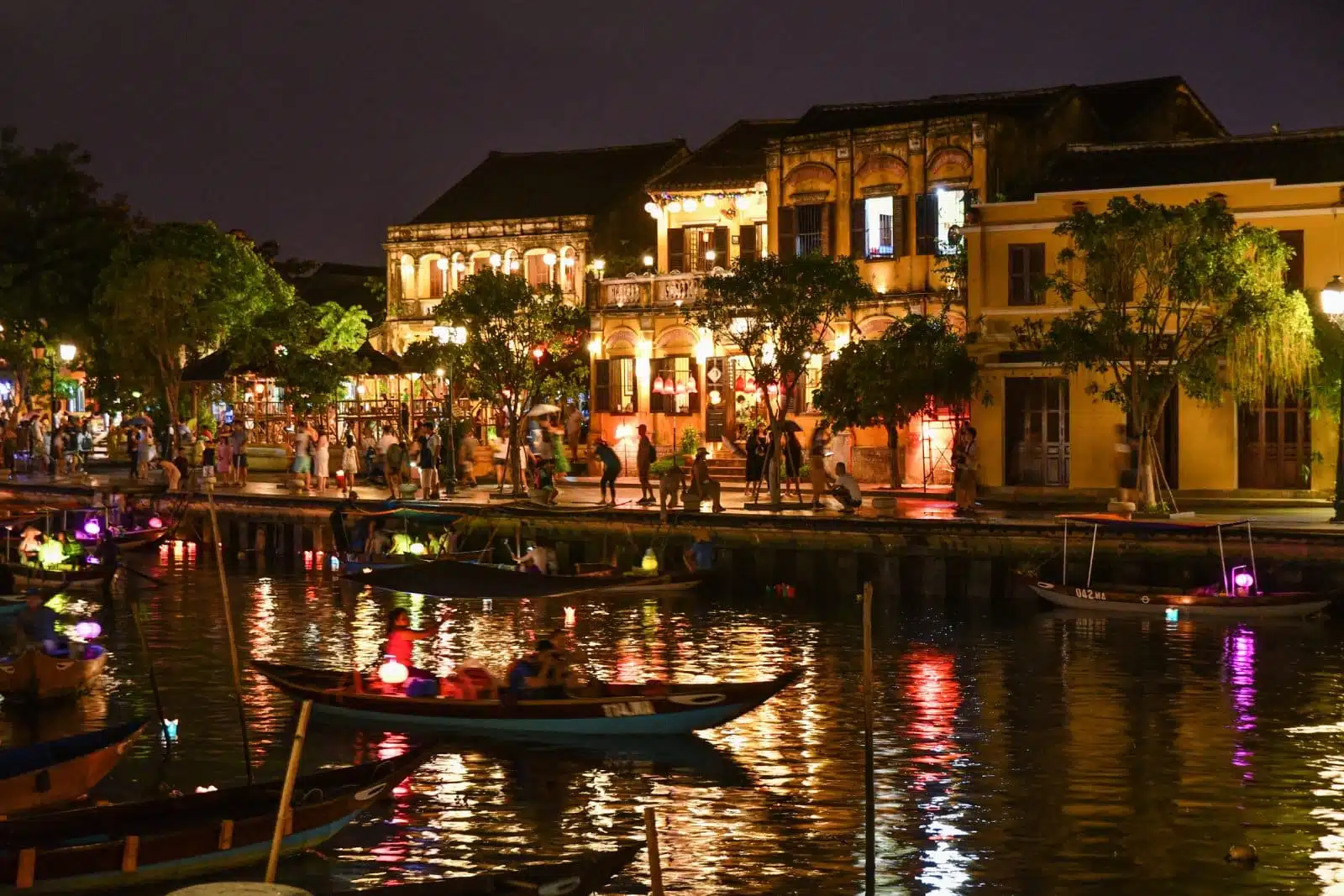
Image Credit: Shutterstock / Jason_yu
Hoi An is a beautifully preserved ancient town that reflects the influences of various Asian and European cultures that have come to its shores over the centuries. Its charming streets are lined with historic homes, tailor shops, and lantern-lit restaurants. The town is also famous for its custom tailoring, vibrant night markets, and the iconic Japanese Covered Bridge. Beyond the town, the countryside reveals lush rice paddies and serene rivers, perfect for bicycle tours.
Insider’s Tip: Visit Hoi An during the full moon to experience the Lantern Festival, when the town turns off its street lights and the river fills with floating lanterns, creating a magical atmosphere.
When to Travel: The best time to visit Hoi An is from February to April, when rainfall is low and temperatures are comfortable.
How to Get There: The nearest airport is Da Nang International Airport, about 30 kilometers from Hoi An. From Da Nang, you can take a taxi or a shuttle bus to Hoi An.
4. Sapa
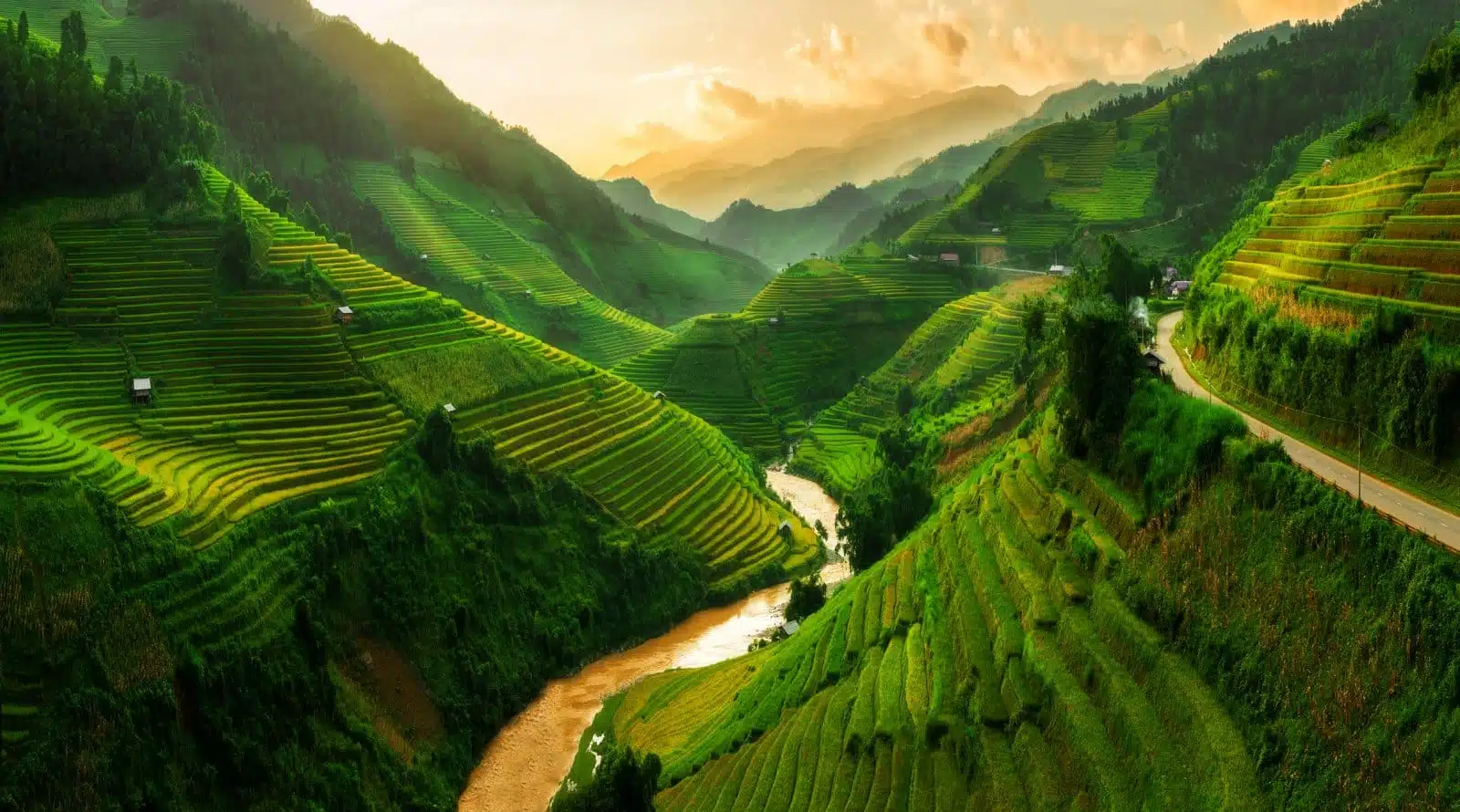
Image Credit: Shutterstock / Summit Art Creations
Nestled in the northern mountains of Vietnam, Sapa is a breathtaking destination known for its terraced rice fields, ethnic diversity, and rugged scenery. This area is home to several ethnic minority groups, each with their unique traditions and lifestyles. Trekking through the rice terraces to visit remote villages offers an intimate glimpse into the daily lives of the local communities. The region’s highest peak, Fansipan, provides challenging treks and, on clear days, panoramic views of the surrounding mountains. Sapa’s market is bursting with colors and cultures, where you can find handcrafted textiles and sample local dishes.
Insider’s Tip: For a truly immersive experience, opt for a homestay with a local family. It’s an unparalleled opportunity to learn about the local culture and traditions firsthand.
When to Travel: The best times to visit Sapa are from March to May and from September to November, when the weather is more temperate and the rice terraces are at their most picturesque.
How to Get There: Sapa is accessible by train from Hanoi to Lao Cai, followed by a short bus or taxi ride. The overnight train offers sleeper cabins for a comfortable journey.
5. Hue
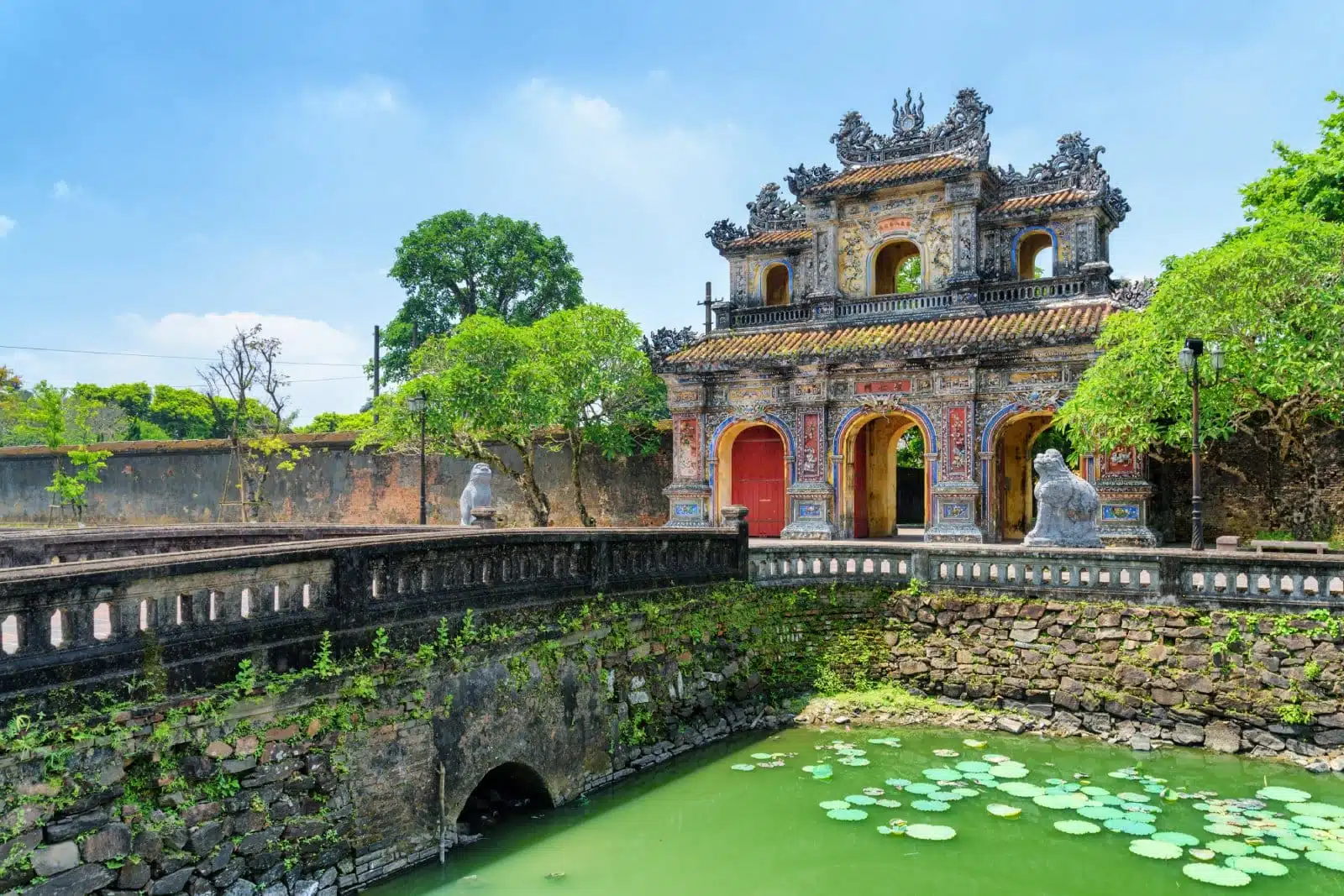
Image Credit: Shutterstock / Efired
Once the capital of Vietnam, Hue is a city that resonates with the glories of imperial Vietnam. At its heart lies the Imperial City, a vast complex of palaces, temples, walls, and gates, highlighting the Nguyen Dynasty’s power. Hue’s culinary scene is renowned for its sophistication, with dishes that were once crafted for royalty. The Perfume River adds a scenic beauty to the city, with boat tours offering a unique perspective on Hue’s landmarks. The city’s serene atmosphere is complemented by its cultural depth, seen in its art, music, and festivals.
Insider’s Tip: Rent a bicycle to explore Hue at your own pace. It’s an eco-friendly way to see the city’s sights and discover hidden gems along the Perfume River.
When to Travel: The best time to visit Hue is from January to April, when the weather is cooler and the risk of rain is lower.
How to Get There: Hue is served by Phu Bai International Airport, located about 15 kilometers from the city center. Direct flights are available from major Vietnamese cities.
6. Phong Nha-Ke Bang National Park
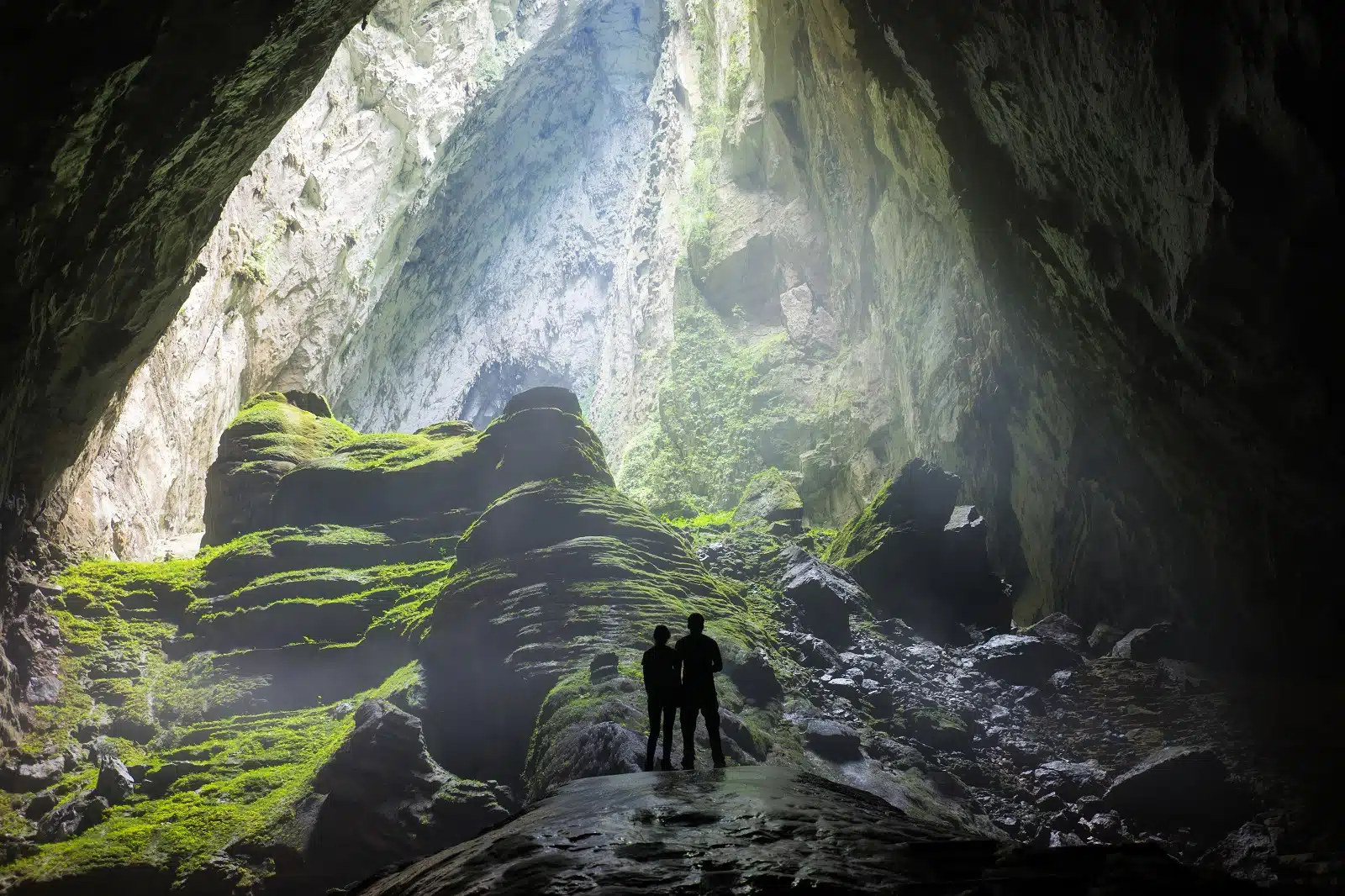
Image Credit: Shutterstock / Vietnam Stock Images
This UNESCO World Heritage site is celebrated for its ancient limestone karsts and vast network of caves, including the world’s largest cave, Son Doong. Phong Nha-Ke Bang is a paradise for adventurers and nature lovers, offering cave exploration, jungle trekking, and river kayaking. The park’s biodiversity is remarkable, with many endemic species. Visiting the caves, you’ll be awestruck by the colossal stalagmites and stalactites, underground rivers, and vast caverns that define this otherworldly landscape.
Insider’s Tip: While Son Doong Cave is on many adventurers’ bucket lists, don’t overlook the other caves in the park. Paradise Cave and Phong Nha Cave offer equally stunning experiences and are more accessible.
When to Travel: The best time to explore Phong Nha-Ke Bang is during the dry season, from February to August, when the caves are most accessible.
How to Get There: The nearest airport is Dong Hoi Airport, from which you can take a bus or taxi to Phong Nha-Ke Bang National Park. The journey from the airport takes approximately 45 minutes.
7. Da Nang
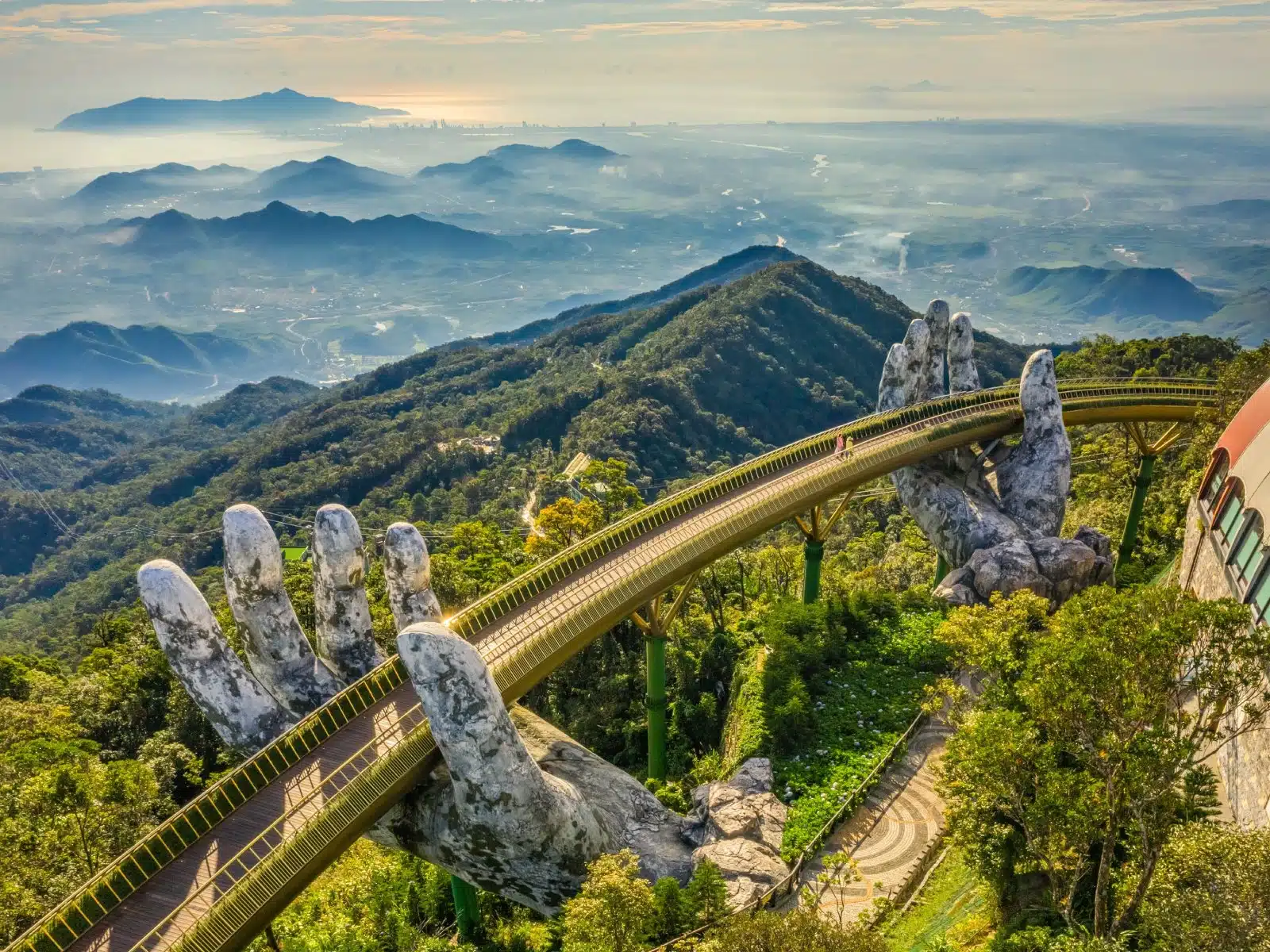
Image Credit: Shutterstock / Hien Phung Thu
Da Nang is a dynamic city that bridges the traditional and the modern, set against a backdrop of white sandy beaches and the Marble Mountains. It’s known for its friendly locals, clean streets, and burgeoning arts scene. Highlights include the Dragon Bridge, which breathes fire and water on weekends, and the Ba Na Hills, home to the Golden Bridge held aloft by giant hands. Da Nang’s beaches, such as My Khe, are perfect for relaxation or water sports, while the nearby Marble Mountains offer caves, temples, and panoramic views.
Insider’s Tip: Visit the Marble Mountains early in the morning to avoid the crowds and the heat. The early light also provides the best conditions for photography.
When to Travel: The best time to visit Da Nang is from February to May, when the weather is warm and dry.
How to Get There: Da Nang International Airport is located within the city, making it easily accessible by air from major cities worldwide.
8. Nha Trang
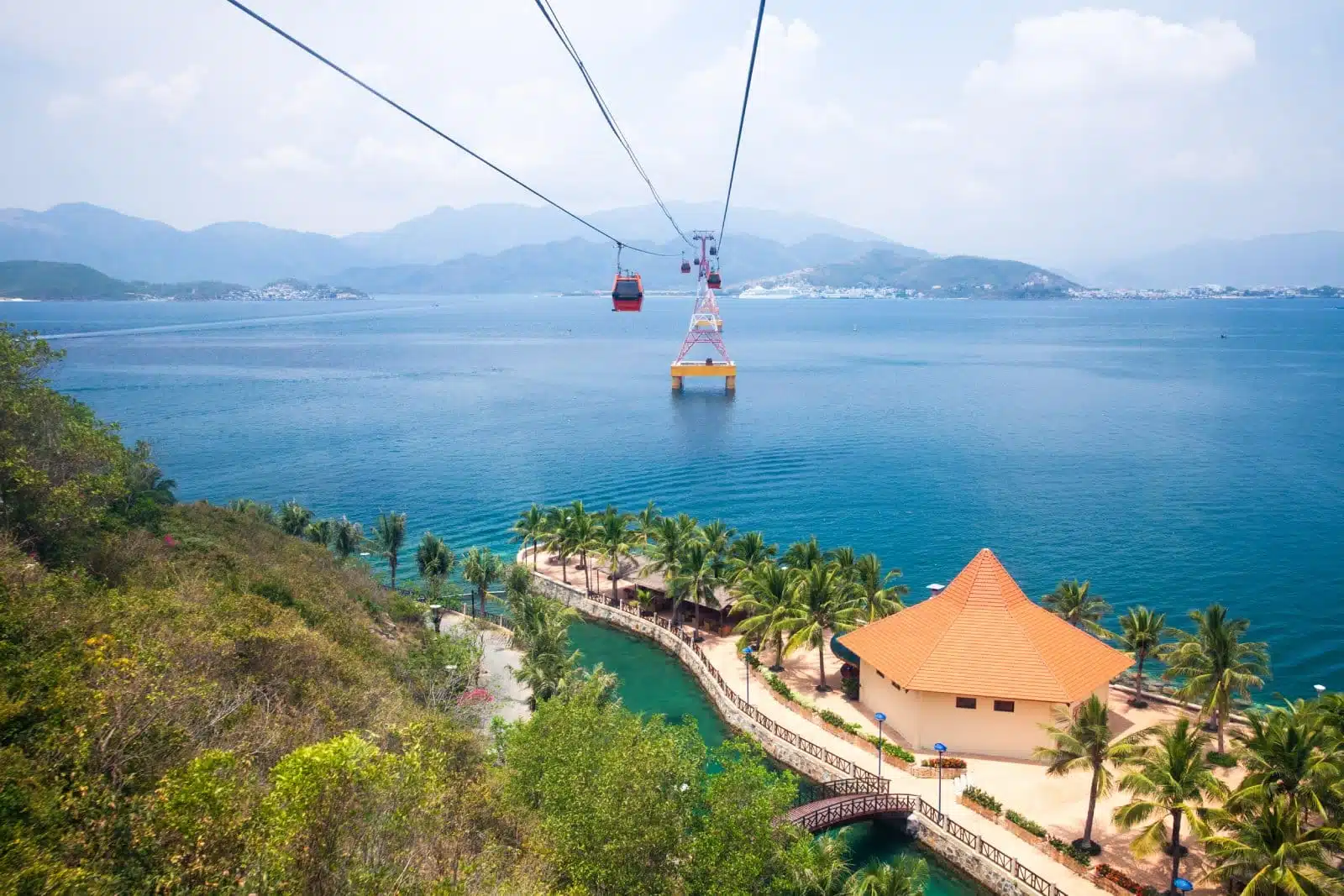
Image Credit: Shutterstock / Elena Ermakova
Nha Trang is renowned for its miles of pristine beaches, thriving marine life, and vibrant nightlife. This coastal city is a haven for water sports enthusiasts, offering excellent conditions for scuba diving, snorkeling, and kite surfing. The city’s backdrop of mountains, islands, and the South China Sea creates a stunning natural setting. Nha Trang’s cultural attractions include the Po Nagar Cham Towers, a remnant of the Cham civilization, and the modern Christ the King Cathedral. The Vinpearl Land amusement park on a nearby island provides entertainment for all ages with water parks, rides, and shows.
Insider’s Tip: For the best snorkeling and diving experiences, book a boat tour to the nearby Hon Mun Island, where the waters are teeming with coral and marine life.
When to Travel: The ideal time to visit Nha Trang is between February and May, when the weather is warm and the water conditions are perfect for swimming and diving.
How to Get There: Nha Trang is served by Cam Ranh International Airport, located about 30 kilometers from the city. Direct flights are available from major Vietnamese cities and some international destinations.
9. Mekong Delta
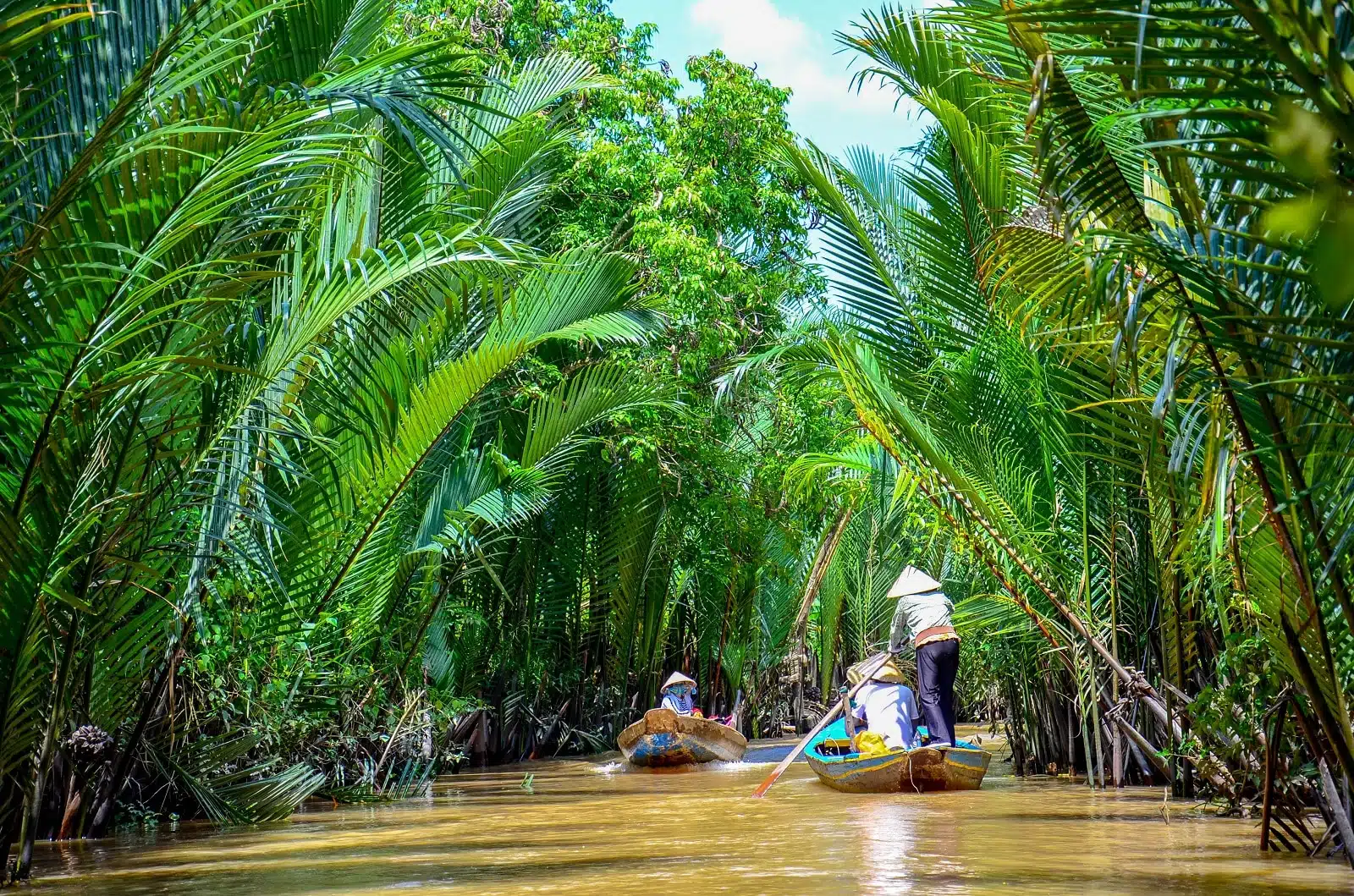
Image Credit: Shutterstock / 1WorldTravels
The Mekong Delta is a vast network of rivers, swamps, and islands in southern Vietnam, known for its fertile lands and traditional riverine lifestyle. This region is made up of rice paddies, fruit orchards, and floating markets. A visit to the Mekong Delta offers an insight into the rural life of Vietnam, with activities such as boat tours, visiting local workshops, and sampling tropical fruits. The floating markets of Cai Rang and Phong Dien are highlights, where you can witness the bustling trade of goods from boats.
Insider’s Tip: For an authentic experience, opt for a homestay in one of the delta’s villages. It’s an opportunity to learn about local agriculture and enjoy home-cooked Vietnamese meals.
When to Travel: The best time to explore the Mekong Delta is during the dry season, from November to January, when the weather is cooler and the risk of flooding is minimal.
How to Get There: The Mekong Delta is accessible by bus or car from Ho Chi Minh City. Can Tho, the largest city in the delta, has an airport with flights to major cities in Vietnam.
10. Da Lat
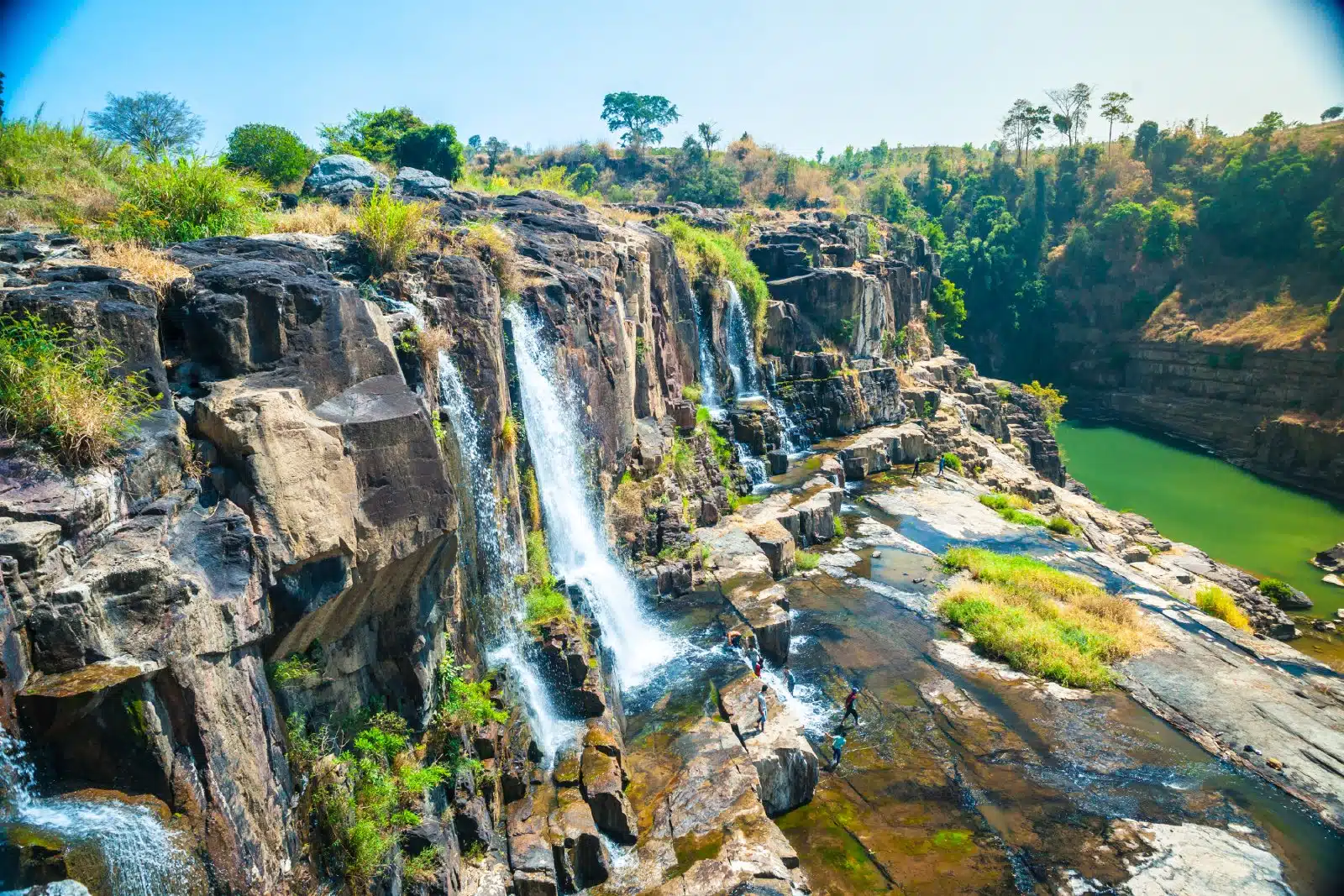
Image Credit: Shutterstock / Romas_Photo
Nestled in the South Central Highlands of Vietnam, Da Lat is known for its mild climate, scenic landscapes, and French colonial architecture. This city is a retreat from the tropical climate, offering lush gardens, serene lakes, and waterfalls. Da Lat is also famous for its agriculture, producing flowers, vegetables, and fruits, especially strawberries. The city’s attractions include the Valley of Love, Da Lat Flower Gardens, and the unique Crazy House, a whimsical guesthouse with organic architecture.
Insider’s Tip: Rent a motorbike to explore the countryside around Da Lat, where you’ll find some of the most picturesque landscapes and hidden waterfalls.
When to Travel: Da Lat can be visited year-round, but the best time is from December to March, when the flowers are in bloom and the temperatures are most pleasant.
How to Get There: Lien Khuong Airport serves Da Lat, with domestic flights from Ho Chi Minh City, Hanoi, and Da Nang. The city can also be reached by bus from major cities in Vietnam.
11. Quy Nhon
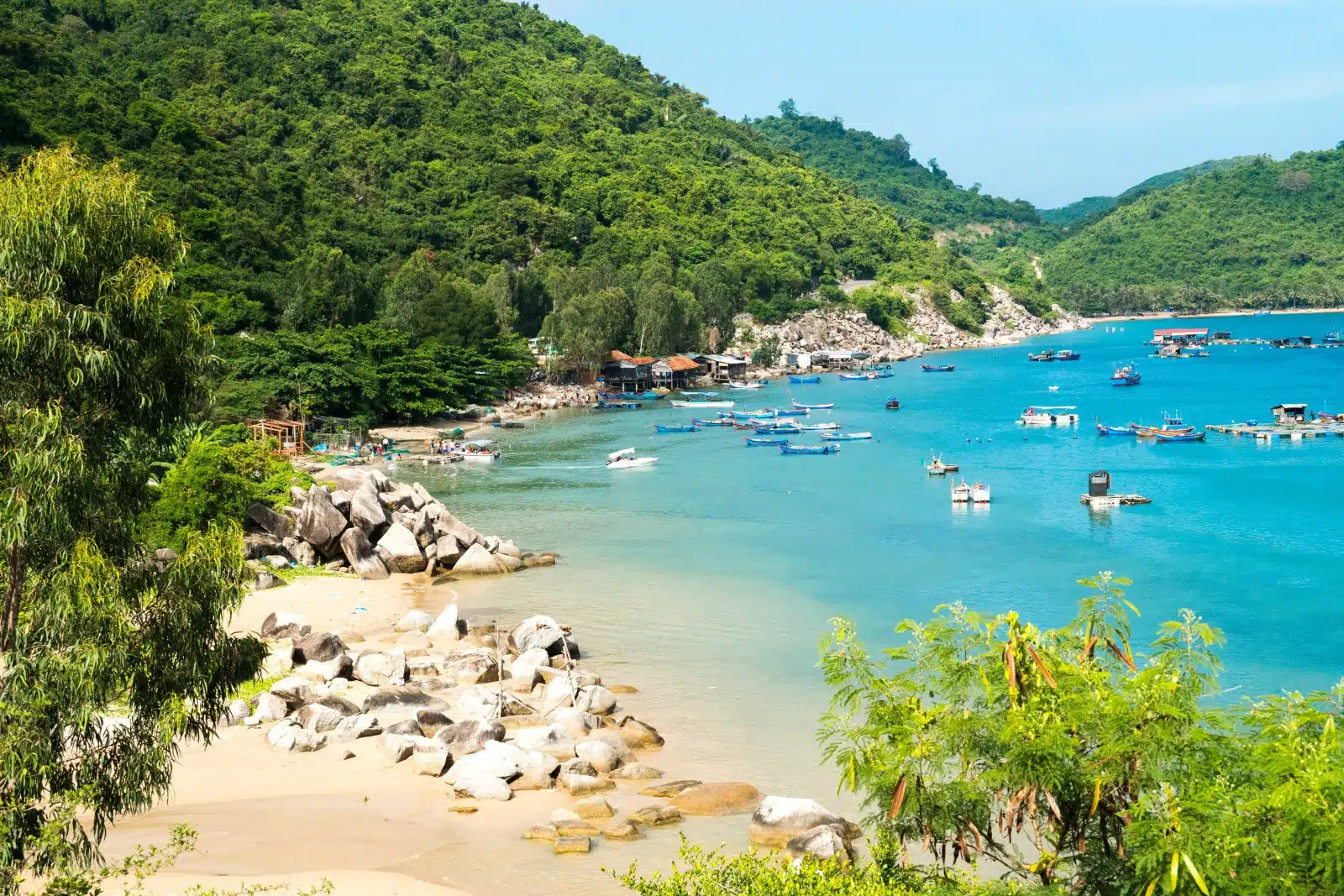
Image Credit: Shutterstock / Jimmy Tran
Quy Nhon, a coastal city in Binh Dinh Province, is gaining recognition for its beautiful beaches, serene landscapes, and historical sites. Unlike its more famous counterparts, Quy Nhon offers a more laid-back atmosphere, making it perfect for those seeking tranquility by the sea. The city is surrounded by pristine beaches such as Ky Co and Bai Xep, which are known for their clear waters and golden sands. Quy Nhon is also rich in history, with the Banh It Towers and Thap Doi Towers showcasing the architectural prowess of the ancient Champa civilization.
Insider’s Tip: Visit the fishing village of Bai Xep, just a short drive from Quy Nhon, for a glimpse into the traditional fishing techniques and a chance to enjoy fresh seafood by the beach.
When to Travel: The best time to visit Quy Nhon is from June to September, when the weather is warm and sunny, which is ideal for beach activities.
How to Get There: Phu Cat Airport serves Quy Nhon with domestic flights from Hanoi and Ho Chi Minh City. The city can also be reached by train or bus from major cities in Vietnam.
12. Phu Quoc Island
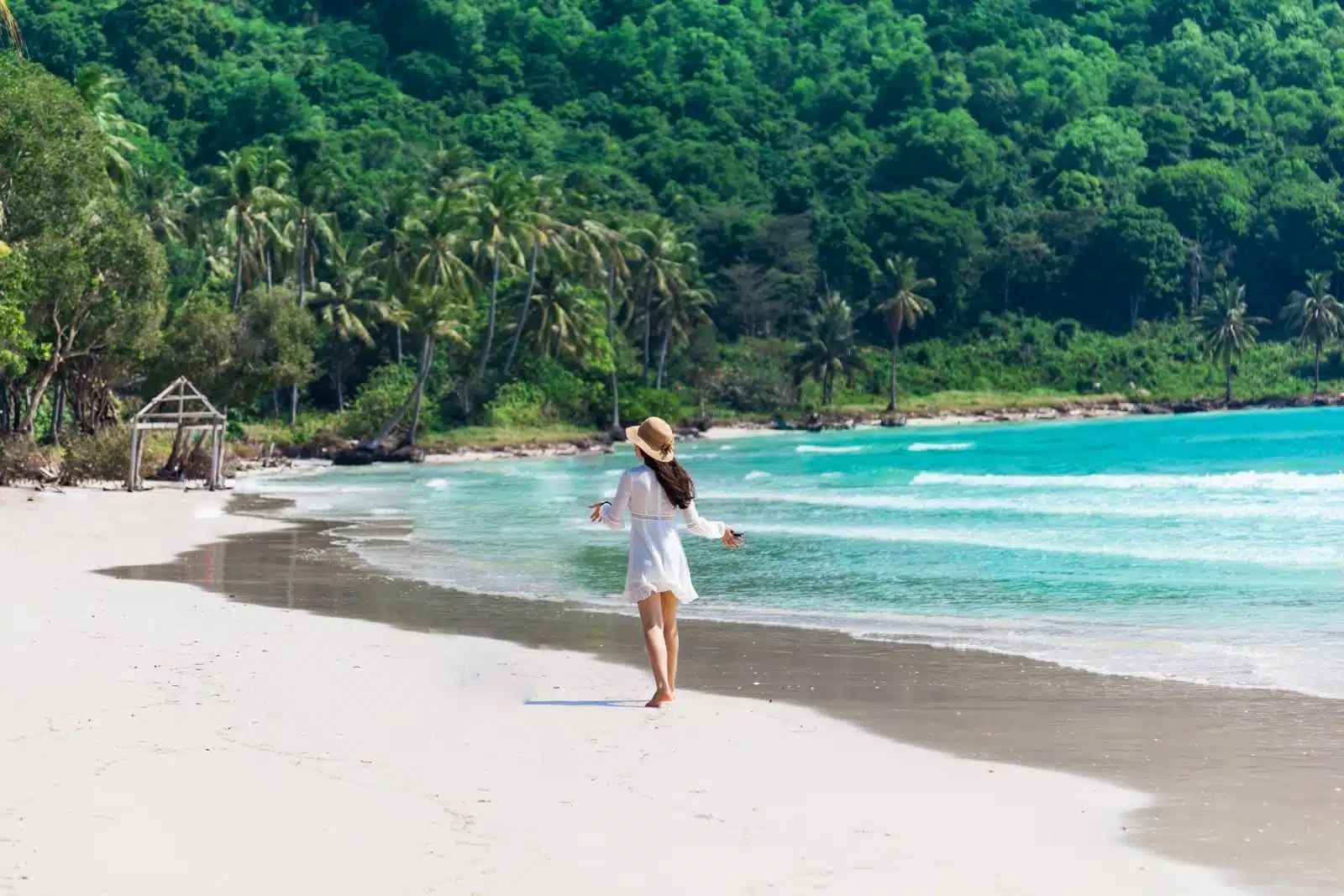
Image Credit: Shutterstock / Oksana Stock
Phu Quoc Island, located in the Gulf of Thailand, is Vietnam’s largest island and a paradise for beach lovers. Known for its white sandy beaches, crystal-clear waters, and lush tropical landscapes, Phu Quoc is perfect for relaxation, snorkeling, and diving. The island is also home to the Phu Quoc National Park, which covers more than half of the island and offers hiking trails through dense tropical forests. Another highlight is the local production of fish sauce, a key ingredient in Vietnamese cuisine, which visitors can learn about through factory tours.
Insider’s Tip: For a unique experience, visit Sao Beach in the early morning to enjoy its beauty in solitude before the crowds arrive.
When to Travel: The dry season from November to March is the best time to visit Phu Quoc, offering sunny days and minimal rainfall.
How to Get There: Phu Quoc International Airport has direct flights from major Vietnamese cities and some international destinations. Ferries also connect the island with mainland Vietnam.
13. Mai Chau
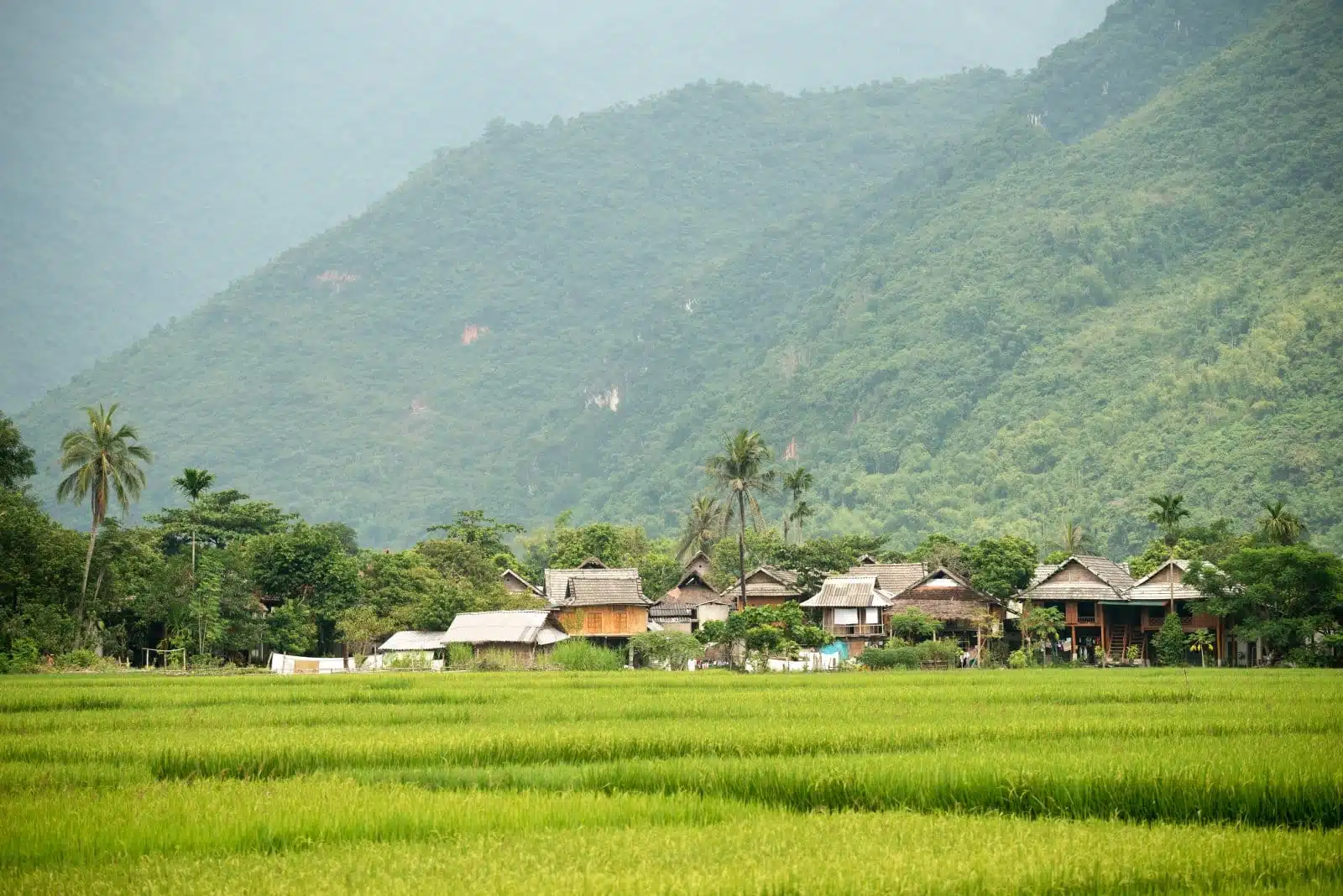
Image Credit: Shutterstock / Chris Howey
Nestled in the northern mountains of Vietnam, Mai Chau offers a peaceful escape into nature with its stunning valleys, rice fields, and ethnic minority villages. This area is less frequented by tourists than Sapa, providing a more intimate experience of Vietnam’s rural life. Visitors can explore the villages of the White Thai ethnic group, known for their stilt houses and weaving skills. Cycling and trekking through the rice paddies and hills offer breathtaking views and the chance to connect with the local way of life.
Insider’s Tip: Stay overnight in a traditional stilt house for an authentic experience of local hospitality and culture.
When to Travel: The best times to visit Mai Chau are from September to November and from February to April, when the weather is pleasant and the rice fields are lush and green.
How to Get There: Mai Chau is approximately a 4-hour drive from Hanoi. Buses and private transfers are available from Hanoi to Mai Chau.
14. Can Tho
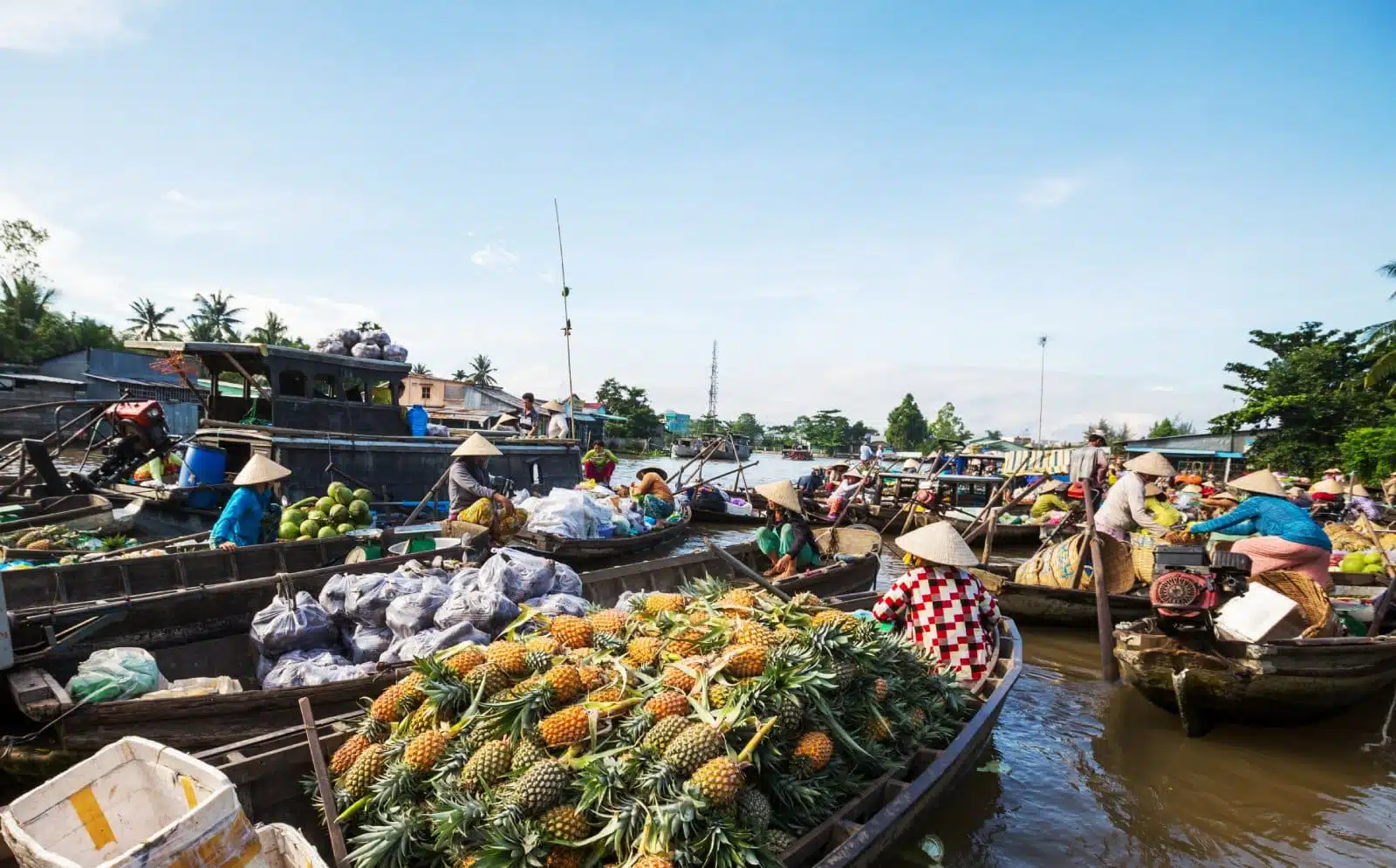
Image Credit: Shutterstock / Galyna Andrushko
Can Tho, often referred to as the capital of the Mekong Delta, is renowned for its floating markets, where boats laden with fruits, vegetables, and goods converge in a colorful and bustling display of local life. The Cai Rang Floating Market is the largest and most famous, offering a glimpse into the delta region’s unique cultural and economic activities. Can Tho also boasts serene waterways, lush orchards, and a vibrant waterfront with cafes and restaurants. The city serves as a gateway to the deeper reaches of the delta, where the rhythms of riverine life continue as they have for centuries.
Insider’s Tip: Take an early morning boat tour to the floating markets to see them at their most lively. It’s also the best time for photography, capturing the golden light of dawn over the river.
When to Travel: The dry season from December to April is ideal for visiting Can Tho, with lower humidity and less rain, making river excursions more enjoyable.
How to Get There: Can Tho is accessible by air via Can Tho International Airport, with flights from Hanoi, Da Nang, and Ho Chi Minh City. Alternatively, it’s a 3 to 4-hour drive from Ho Chi Minh City.
15. Con Dao Islands

Image Credit: Shutterstock / Tiep.Nguyen
The Con Dao Islands, a group of 16 islands in the South China Sea, are celebrated for their pristine beaches, clear blue waters, and rich history. Once known for the infamous Con Dao Prison, where Vietnamese revolutionaries were incarcerated during the French colonial era, the islands now serve as a national park with diverse ecosystems, including coral reefs, mangroves, and tropical forests. The archipelago offers excellent opportunities for diving, snorkeling, trekking, and the chance to see rare wildlife, such as the endemic Con Dao black squirrel and sea turtles that come ashore to nest.
Insider’s Tip: Plan your visit between June and September to witness sea turtles nesting on the beaches. The Con Dao National Park organizes night tours for visitors to observe this remarkable natural phenomenon.
When to Travel: The best time to visit the Con Dao Islands is from March to June when the sea is calm, making it ideal for water activities and exploring the islands.
How to Get There: Con Dao can be reached by flight from Ho Chi Minh City to Con Dao Airport or by ferry from Vung Tau, though the sea journey can be long and depends on weather conditions.
16. Tam Coc – Bich Dong
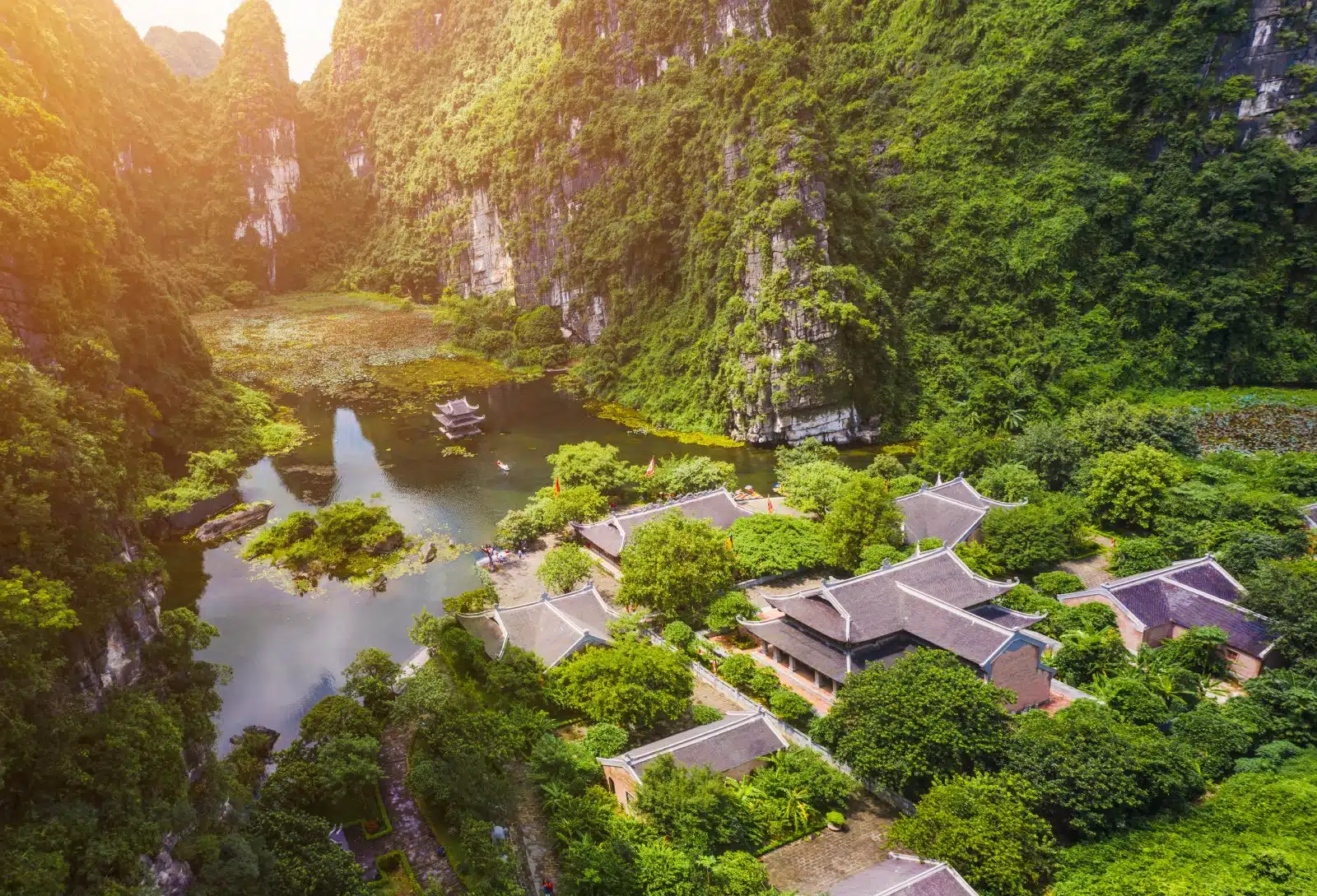
Image Credit: Shutterstock / CravenA
Often referred to as the “Halong Bay on Land,” Tam Coc – Bich Dong in Ninh Binh province offers a stunning landscape of limestone karst peaks, surrounded by rice paddies and intersected by serene rivers. A boat ride through Tam Coc reveals three natural caves formed in the limestone hills, while Bich Dong Pagoda offers a spiritual retreat with its ancient pagodas built into the limestone cliffs. The area is also known for its cycling routes, allowing visitors to explore the countryside and its traditional villages.
Insider’s Tip: Visit during the late spring (May or June) when the rice fields are a vibrant green, creating a breathtaking backdrop for your boat ride or cycling tour.
When to Travel: The best times to visit are from November to April, avoiding the rainy season, and in late spring for the lush green rice paddies.
How to Get There: Tam Coc – Bich Dong is approximately a 2-hour drive from Hanoi. It’s easily accessible from the capital by bus, train, or private car.
The Bottom Line
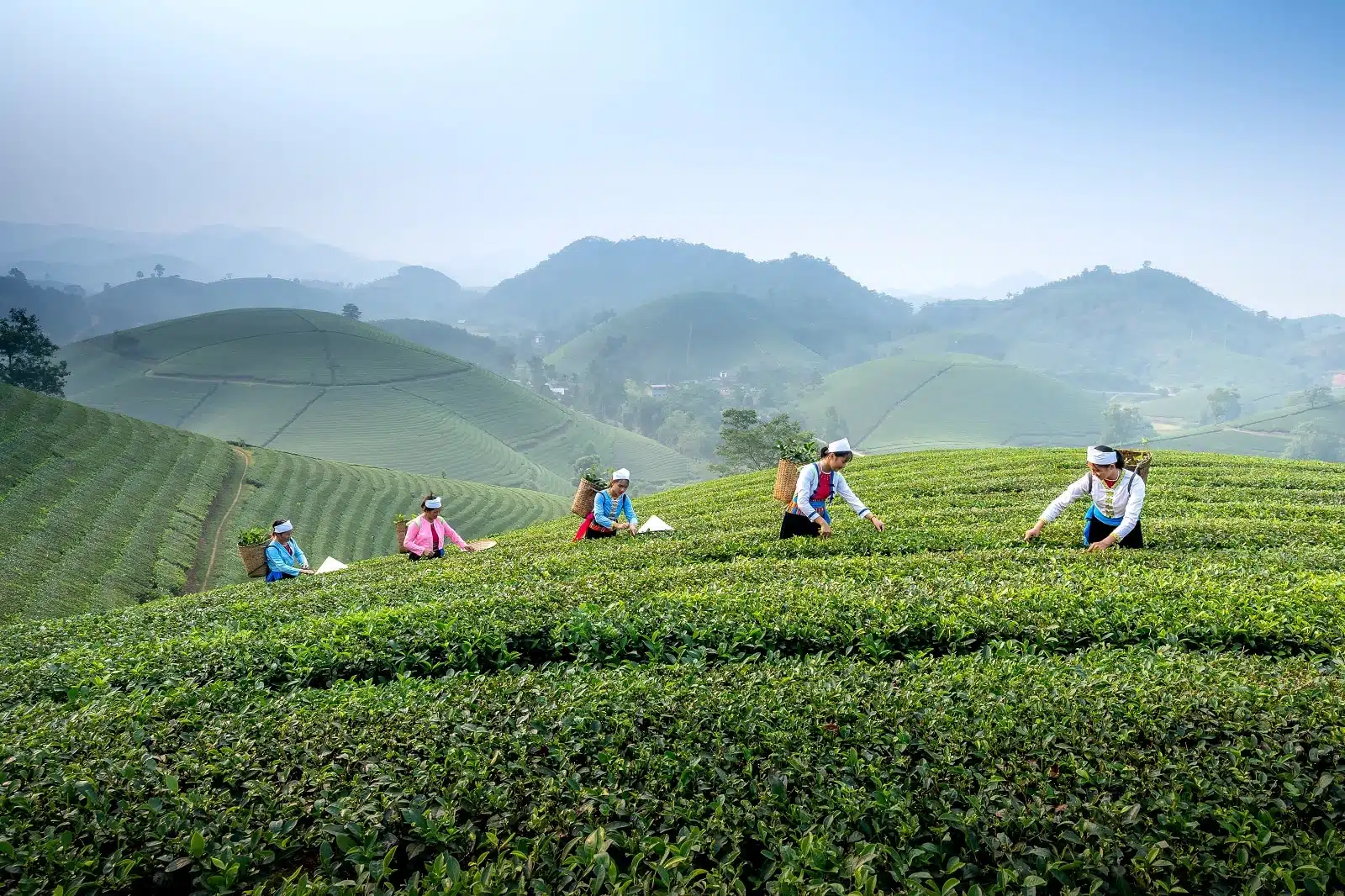
Image Credit: Shutterstock / Quang nguyen vinh
Vietnam’s charm lies in its ability to offer many experiences, from the tranquility of its beaches and the serenity of its rural landscapes to the vibrancy of its cities and the richness of its cultural heritage. Each destination within this guide offers a unique perspective on Vietnam, inviting travelers to explore its beauty, engage with its people, and immerse themselves in its culture. Whether you’re trekking through the mountains of Mai Chau, lounging on the beaches of Phu Quoc, or exploring the historical sites of Quy Nhon, Vietnam promises a journey filled with discovery and enchantment.
More From The Green Voyage
Top 10 Trending Travel Destinations 2024
6 Essential Banking Apps for International Travel – Managing Your Finances on the Go
Traveling With Kids – 10 Tips to Create Memorable Family Holidays
The post A Country Guide to Vietnam first appeared on The Green Voyage.
Featured Image Credit: Shutterstock / Nguyen Quang Ngoc Tonkin.
For transparency, this content was partly developed with AI assistance and carefully curated by an experienced editor to be informative and ensure accuracy.
Tips for Trip Success
Book Your Flight
Find an inexpensive flight by using Kayak, a favorite of ours because it regularly returns less expensive flight options from a variety of airlines.
Book Your Hotel or Special Accommodation
We are big fans of Booking.com. We like their review system and photos. If we want to see more reviews and additional booking options, we go to Expedia.
You Need Travel Insurance!
Good travel insurance means having total peace of mind. Travel insurance protects you when your medical insurance often will not and better than what you get from your credit card. It will provide comprehensive coverage should you need medical treatment or return to the United States, compensation for trip interruption, baggage loss, and other situations.Find the Perfect Insurance Plan for Your Trip
